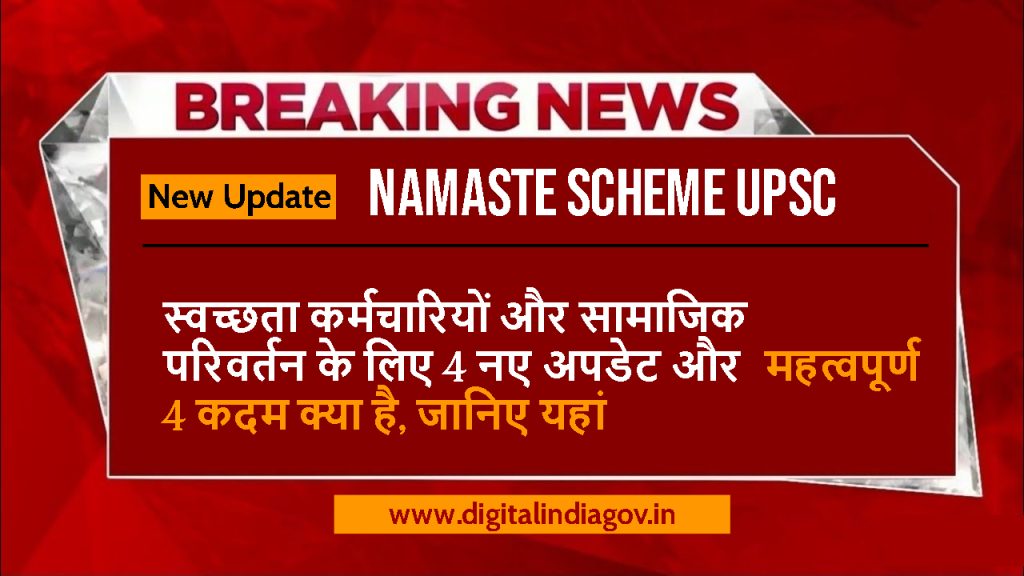NAMASTE Scheme UPSC, Eliminating manual scavenging and advancing the mechanisation of sanitation services in India are the goals of the National Action for Mechanised Sanitation Ecosystem (NAMASTE) Scheme. This program is essential for public health and social welfare since it gives sanitation workers a respectable means of subsistence. It is crucial that candidates for the exam understand the NAMASTE Scheme because it is pertinent to topics like social justice, governance, and health that are regularly covered in the UPSC syllabus. This essay will examine every aspect of the NAMASTE Scheme, including its features, objectives, and importance for UPSC preparation.
Contents
What is the NAMASTE Scheme?
The NAMASTE Scheme was introduced in order to swap out risky manual scavenging for secure, automated cleaning. Together with doing away with the cruel practice of manual scavenging—which has been illegal in India since 1993 but is nevertheless practised in some areas—it also seeks to enhance the health, safety, and working conditions of sanitation workers.
Key features of the NAMASTE Scheme:
- Mechanisation of Sanitation: Promotes the use of equipment to clean sewers and septic tanks.
- Rehabilitation of Sanitation Workers: Assists sanitation workers in transitioning to more respectable occupations.
- Health and Safety: Provides sanitation workers with safety gear and health insurance.
- Skill Development: Provides employees with the upskilling they need to go into different types of jobs through training programs.
Also Read: EPF Pension Scheme, shaladarpanportalgov.com, yojanaforall.com, Onlinereferjobs
Objectives of the NAMASTE Scheme

The NAMASTE Scheme has a number of main objectives that are consistent with India’s larger objectives of social justice, inclusion, and public welfare. Among these goals are:
- Elimination of Manual Scavenging: The main goal of NAMASTE is to completely do away with manual scavenging.
- Respected Employment: The program seeks to offer respectable and long-term job options to sanitation workers.
- Health and safety: Making certain that sanitation employees have access to the tools and medical treatment they need to stay safe at work.
- Skill Development and Rehabilitation: To assist sanitation workers in making the move to safer, more respectable careers, NAMASTE provides education and training programs.
- Encouraging Social Equality: The program tackles the socioeconomic exploitation of manual scavengers as well as discrimination based on caste.
Historical Background and the Need for the NAMASTE Scheme
India’s socioeconomic framework has included the dehumanising practice of manual scavenging for generations. Many regulations, like the Construction of Dry Latrines (Prohibition) Act of 1993 and the Prohibition of Employment as Manual Scavengers and their Rehabilitation Act of 2013, forbid manual scavenging, yet it remains illegal in some parts of the country.
The NAMASTE Scheme came into existence because
- The extant legislation was insufficient as it did not ensure the complete eradication of manual scavenging due to improper execution.
- Persistent Discrimination: The majority of manual scavengers come from marginalised populations, and as such, they face severe social shame in addition to economic exploitation.
- Dangerous Working Conditions: Sanitation workers run the risk of death if they do not have the appropriate machinery and protective gear.
Key Features of the NAMASTE Scheme
It’s critical to look at the NAMASTE Scheme’s main components in order to comprehend it fully:
- Mechanisation of Sanitation: To prevent human interaction with hazardous waste, one of NAMASTE’s most important elements is the promotion of mechanised cleaning techniques.
- Programs for Skill Development: This initiative helps sanitation workers move into safer careers by offering them vocational training.
- Rehabilitation and Employment: NAMASTE provides alternative livelihood possibilities, like entrepreneurship programs, to assist with the rehabilitation of manual scavengers.
- Health and Safety Measures: The plan guarantees health insurance coverage and the provision of safety gear to sanitation workers.
- Cooperation with Local Bodies: The program maintains close ties with urban local bodies (ULBs) to guarantee the efficient deployment of automated cleaning systems and the training of sanitation personnel.

Also Read: SCSS Scheme In Post Office, Mobilenumbertrackeronline, indnewsupdates.com, ssorajasthanidlogin.com
NAMASTE Scheme and Social Justice
In order to address India’s social justice issues, the NAMASTE Scheme is essential, especially when it comes to underprivileged groups like manual scavengers. The plan is intended to:
- Stop Caste-Based Exploitation: Caste-based discrimination, which involves forcing lower-caste populations to perform dangerous sanitary chores, is frequently linked to manual scavenging. The goal of NAMASTE is to end this kind of exploitation.
- Promote Equality: The program aims to lessen social inequality by providing alternative livelihood alternatives and rehabilitation to manual scavengers.
- Empowerment through Employment: NAMASTE enables sanitation workers to achieve financial independence and social respect by offering skill development and employment possibilities.
NAMASTE Scheme and Sustainable Development Goals (SDGs)
A crucial subject for UPSC candidates getting ready for questions on national and international development objectives is the NAMASTE Scheme, which helps to achieve a number of the Sustainable Development Goals (SDGs) of the United Nations.
Relevant SDGs related to the NAMASTE Scheme:
- Goal 1: No Poverty: By assisting sanitation workers in moving into respectable careers, the program helps them improve their socioeconomic circumstances.
- Goal 3: Good Health and Well-Being: Encouraging health and safety among sanitation workers increases their access to healthcare.
- Goal 6: Clean Water and Sanitation: The program supports efforts for clean water and sanitation by encouraging the use of safe sanitation methods.
- Goal 8: Decent Work and Economic Growth: NAMASTE promotes both decent work and economic growth by offering employment possibilities through skill development.
Implementation of the NAMASTE Scheme
Urban local bodies (ULBs) actively participate in the central and state implementation of the NAMASTE Scheme. The principal organisations engaged in the execution are:
- The Ministry of Social Justice and Empowerment (MSJE) is the main organisation in charge of carrying out the program as a whole.
- State Governments: It is the duty of state governments to work with ULBs to identify manual scavengers and provide them with training and rehabilitation.
- Urban Local Bodies (ULBs): Under their purview, ULBs are essential to the implementation of automated sanitation systems and the rehabilitation of manual scavengers.
Challenges in the Implementation of the NAMASTE Scheme
Although the NAMASTE Scheme is a commendable endeavour, its successful implementation faces multiple obstacles:
- Lack of Awareness: Low participation is caused by many sanitation workers’ ignorance of the program’s advantages.
- Opposition to Mechanisation: In certain places, especially in rural and semi-urban areas, the lack of mechanised equipment forces people to use manual sanitation techniques.
- Social Stigma: Former manual scavengers still experience social stigma even after switching to other jobs, which makes recovery difficult.
- Resources and Finances: The complete use of mechanised cleaning techniques is impeded by inadequate financial allocation and inadequate equipment.
NAMASTE Scheme in the Context of Other Government Initiatives
The NAMASTE Scheme complements a number of other government initiatives that aim to promote social equity and better sanitation. Important initiatives include:
- Swachh Bharat Mission (SBM): NAMASTE mechanises sanitation activities to alleviate the manual labour issue, while SBM concentrates on enhancing sanitation infrastructure.
- Skill India Mission: The NAMASTE Scheme, which offers sanitation workers vocational training, is in line with the Skill India Mission.
- Mantri Pradhan Jan Arogya Yojana (PMJAY): As part of the NAMASTE Scheme, sanitation workers are frequently eligible for health coverage under PMJAY.

The Role of Civil Society in the Success of the NAMASTE Scheme
CSOs, or civil society organisations, have been instrumental in the NAMASTE Scheme’s success. They support in:
- Increasing Awareness: CSOs endeavour to increase marginalised populations’ knowledge of the program.
- Advocacy: These groups serve as a liaison between government authorities and sanitation workers, advocating for improved plan implementation.
- Offering Training: Several CSOs support the initiative by helping to provide career and skill development training for sanitation personnel.
Also Read: Agniveer Scheme Salary, digitizeindiagovin.com, Typingspeedtestonline, Nebsit Council
Conclusion
The NAMASTE Scheme is a ground-breaking initiative aimed at ending manual scavenging and giving sanitation workers a decent wage. Due to its emphasis on mechanisation, safety, health, and rehabilitation, it is an essential component of India’s social justice initiatives. It is imperative for UPSC candidates to understand the NAMASTE Scheme since it covers important subjects like social justice, governance, and sustainable development. It is extremely pertinent for competitive tests since it demonstrates the government’s commitment to human dignity and inclusive progress.
Faq’s
Q. What is the NAMASTE Scheme?
Ans: The Indian government introduced the National Action for Mechanised Sanitation Ecosystem, or NAMASTE Scheme, to discourage manual scavenging and encourage the mechanisation of sanitation services. It offers sanitation workers health care, skill development, and rehabilitation.
Q. Why is UPSC interested in the NAMASTE Scheme?
Ans: The NAMASTE Scheme is pertinent to the test since the General Studies papers and essays on the UPSC syllabus address social justice, inclusive governance, health, and sanitation.
Q. What goals does the NAMASTE Scheme aim to achieve?
Ans: The principal aims are to terminate manual scavenging, offer decent employment opportunities for sanitation workers, protect their health and well-being, and facilitate their rehabilitation through skill-development initiatives.
Q. Is there a Namaste Scheme registration process?
Ans: Typically, prospective applicants must register through the official government website or through one of the program’s participating educational institutions.
@PAY
